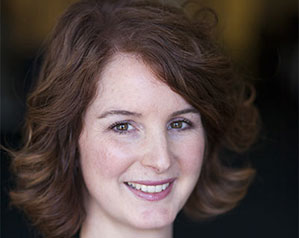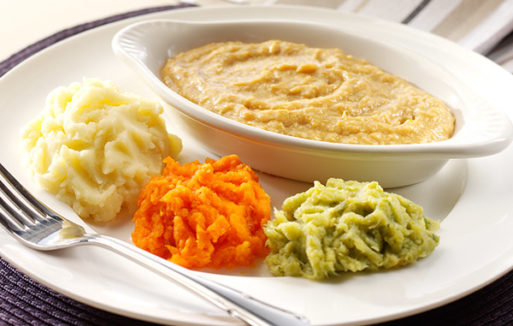
Credit: speech.steinhardt.nyu.edu
Today, SevenPonds speaks with speech-language pathologist Erin Embry. Erin holds a dual degree in both Communication Sciences and Disorders and Health Policy and Management. She is also Director of the Speech@NYU online MS program in Communicative Sciences and Disorders and the graduate student academic advisor. In her clinical work, Erin has focused on treating swallowing disorders. She recently contributed to a cookbook featuring recipes tailored to meet the needs of those who suffer from dysphagia.
Ellary: Hi Erin! Thank you so much for taking the time to speak with SevenPonds. Your work sounds very exciting! Can you start by giving me a brief rundown of what you do in your role as Director of the Speech@NYU online MS program in Communicative Sciences and Disorders?
Erin Embry: In my role as Director of the Speech@NYU — NYU Steinhardt’s online masters in speech and language pathology – an online MS program in Communicative Science and Disorders, I develop and teach courses related to the clinical process, swallowing disorders, and professional issues. I also am involved in department and school-wide curriculum development with a focus on cultivating collaborative efforts of various disciplines in the educational and healthcare settings. My approach to teaching and leadership is to promote interdisciplinary collaboration at all levels of academic, clinical and professional training.
Ellary: You have over 15 years of experience as a licensed and certified speech-language pathologist. When did you become interested in speech disorders and how did you decide to make the treatment and studying of speech pathologies your life’s work?

Credit: medicalnewstoday.com
Erin: A career in the medical field always interested me. I also had an equal interest in working with individuals across the lifespan with disabilities. The profession of speech-language pathology was the perfect intersection between the two.
Ellary: During your academic career you’ve focused on helping adults with acquired brain injuries and progressive neurological diseases with a primary focus on dysphagia. What led you to this specialty?
Erin: Early in my academic and clinical training, I was drawn to the health care setting and excited by the opportunity to work collaboratively with a variety of different health professionals to meet the needs of patients with a multitude of medical diagnoses and issues. A rehabilitation team organically thinks in terms of quality of life issues, and eating and socializing is typically at the center of those. Understanding that, the area of dysphagia was a natural fit for me. It allowed me to play a key role in helping my patients safely return to these essential activities of life. In addition, I also enjoyed the clinical process of identifying and treating the underlying causes of chewing and/or swallowing difficulties, while appreciating the unique cultural, physiological and interpersonal differences of each patient.
Ellary: Will you explain what dysphagia is?
Erin: Dysphagia is the medical term for difficulties swallowing and eating. Needless to say, the simple act of eating is anything but for those who suffer from dysphagia.

A speech-language pathologist evaluates a patient for dysphagia
Credit: speech.steinhardt.nyu.edu
Ellary: Who suffers from dysphagia? Why do older adults tend to suffer disproportionally from dysphagia?
Erin: Anyone can experience dysphagia, but the condition is more frequent in older adults. The U.S. Department of Health suggests that about 15 percent of the elderly population experiences some form of dysphagia. There are a wide variety of symptoms, such as the inability to safely chew and swallow normal food or refusing textured food or liquid. As a result of dysphagia, people are at risk for dehydration, poor nutrition and social isolation during eating situations.
Ellary: What is NYU Steindhardt’s Dysphagia Iron Chef Competition and how did the annual competition get started?
Erin Embry: The Dysphagia Iron Chef Competition is a challenge that is the culminating experience of one of the Speech@NYU courses, “Interdisciplinary Case-Based Management of Dysphagia.” Students from the varied disciplines of communicative sciences and disorders and nutrition and food studies are given a hypothetical patient profile. Once they have collaborated to analyze the needs of their patient (including their medical diagnosis, recommended diet, and cultural and psychosocial considerations), they develop recipes to meet their patients’ individual needs. Then, the different recipes are tested and ultimately judged. This year was the fifth annual Dysphagia Iron Chef Competition.
Ellary: Who judges the competition and how are the recipes evaluated?
Erin: This year, the judges consisted of an esteemed panel from NYU Steinhardt, Rusk Rehabilitation, and the food and nutrition communities. Two of our “celebrity judges” were Rocco DiSpirito and Michael Ferraro. They judged the recipes on creativity, taste, texture, nutrition and overall eating experience.
Ellary: You recently contributed to a cookbook called “Dining With Dysphagia.” How did this cookbook come together?
Erin: The “Dining with Dysphagia: A Cookbook” is a result of the Dysphagia Iron Chef Competition. Every year, we take the winning recipes from the competition and create an book full of delicious, easy recipes that are aimed at making eating an enjoyable experience for patients with all levels of swallowing difficulties. This particular recipe book outlines eight easy-to-follow and easy-to-swallow recipes that, quite frankly, anyone would enjoy. I’ve made a few of them myself! This cookbook is also meant to be the catalyst to starting a larger conversation around dysphagia.

A dysphagia diet doesn’t have to be boring
Credit: softerfoods.co.uk
Ellary: What do the recipes aim to achieve? What makes a recipe intended for someone with dysphagia different from recipes intended for someone who doesn’t have dysphagia?
Erin: Each year, the simple act of eating becomes a serious challenge for millions of people. As I mentioned, older adults are disproportionately affected, but dysphagia can become a challenge to just about anyone, including children and those with diseases such as Parkinson’s, head and neck cancers, acute neurological conditions, and many more. Caregivers, hospitals, and families caring for those with dysphagia might have to alter the textures of the foods and liquids in order to meet nutrition and medical needs.
Unfortunately, the affected people all too often find that the food is unappetizing and doesn’t take into account cultural food preferences. Likewise, a minimal focus is placed on aesthetics. These foods are often presented as “mushy.” To change this dynamic, the recipes in “Dining with Dysphagia: A Cookbook” take things up a notch, elevating pureed food to a higher standard. By focusing on all of the values foodies would appreciate – enhancing flavor, texture, aroma, and, of course, deliciousness – these recipes make the joy of eating available to everyone. Food should always nourish the body and soul. We should never assume that because a patient has swallowing problems that their food choices will be limited to pureed mush.
Ellary: The recipe contributions take into account the diversity of cultural backgrounds that dysphagia patients come from. How does accounting for this diversity affect ingredient choices?
Erin: While the recipes were evaluated for the overall joy of eating good food, the judges also took into consideration that dysphagia clients come from different cultural backgrounds. Diversity in ingredients and balanced tastes should be enjoyed by everyone – even those with chewing and swallowing difficulties.

Credit: dysphagiasupply.com
Ellary: Can you talk a little bit about dysphagia management beyond adjusting one’s diet? What are the other aspects of a typical treatment plan?
Erin: It’s incredibly important to consult with your doctor (or your loved one’s doctor) regarding dietary and medical requirements based on your specific dysphagia condition. A medical professional will be able to provide you with a comprehensive treatment plan, because everyone is different. This cookbook represents only suggestions to improve flavor and eating experience, not a medical opinion.
Ellary: Thank you, Erin, for sharing your expertise and speaking with SevenPonds!
Erin: You’re very welcome!

 What is Dysphagia and How Can The Eating Experience Be Enhanced For Those Who Suffer?
What is Dysphagia and How Can The Eating Experience Be Enhanced For Those Who Suffer?



 Our Annual Seven Holiday Gifts for Someone Who Is Grieving, 2024 Edition
Our Annual Seven Holiday Gifts for Someone Who Is Grieving, 2024 Edition
 “The Funeral” by Matt James
“The Funeral” by Matt James














